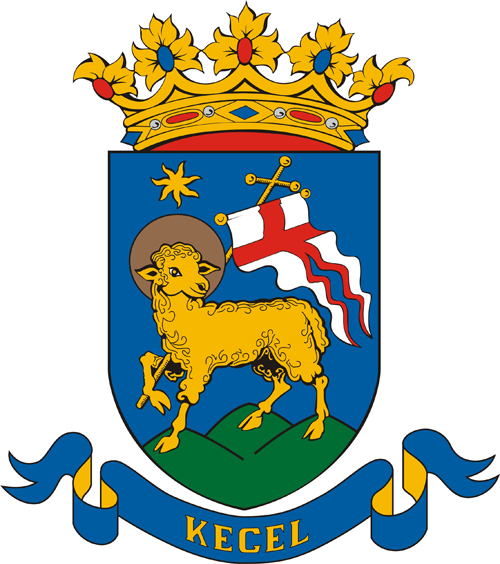
(Bács-Kiskun megye)
Álló, három szegletű pajzs, kék mezőjében hármas zöld halom.
A halmokon Isten Báránya (Agnus Dei) jobb felé lépdel. Fejével visszafordulva kitekint a képből. Színe arany. Jobb lábát felemelve vörös keresztes két szárnyú körmentei zászlót (feltámadási zászlót) tart. A bárány feje felett hétágú arany csillag lebeg.
A címerpajzsot ötágú, nyitott, ékkövekkel díszített, heraldikai korona fedi. A pajzs alatt kék szalagon arany betűkkel a város neve olvasható.
A címer szimbolikus jelentése:
A település első írásbeli említésével egy 1198-ban készült oklevélben találkozunk. Békés pásztornép lakta az Árpád-házi királyok idején az országot. A századok során tatárjárás, török dúlás szórta szét az itt élőket. Kecel 1584-ben végleg elnéptelenedett.
A mai Kecel születésnapja 1734 április 22. Ezen a napon adta ki Patachich Gábor kalocsai érsek Kecel újratelepítését elrendelő oklevelét.
A címerkép ezt az újjászületést szimbolizálja. Mint ahogy harmadnapra, húsvét vasárnap virradóra, Jézus Krisztus, "az Isten Báránya" (Agnus Dei), a halottaiból feltámadt, úgy támadt fel a több évszázados tetszhalálból Kecel települése és közössége. Mindez az itt lakó emberek szorgalmának, munkájának, kitartásának gyümölcse. Újratelepítéskor a címerben szereplő hármas halommal jelölték Kecel határait, melyből egy fennmaradt az utókornak. Kecel 1993 óta város. A címert díszítő korona a városi rangra utal.
A hétágú csillag a tökéletességre való törekvést, a háttér a kék eget szimbolizálja.
(The County of Bács-Kiskun)
Triangular shield erect. In field azure a triple mound vert. On the mounds the charge of God’s Lamb (Agnus Dei) or is borne statant. Its head is turning back as if looking out of the picture. Its dexter foot is raised and a double-tailed processional flag (symbolising Resurrection) is borne in it. Above the lamb’s head a seven-pointed star or is borne encouped.
Shield is topped by a five-pointed open heraldic crown, decorated with gems. Below the shield a ribbon azure with the settlement’s name inscribed in it in letters or.
The symbolism of the settlement’s coat of arms is as follows:
The settlement’s name got first mentioned in a document of 1198. In the period of the kings of Árpád’s dynasty the area was inhabited by peaceful nomadic people. In the centuries to come the Mongol invasion and then the Turkish rule destroyed the early settlement as well as its inhabitants. By 1584 Kecel got depopulated.
The modern settlement came into being on April 22, 1734. The foundation document of the reborn settlement was issued on this day by Gábor Patachich, archbishop of Kalocsa.
The main charge in the settlement’s coat of arms is symbolical of this rebirth. As God’s Lamb (Agnus Dei) got resurrected at dawn on Easter Sunday, so the community of Kecel’s inhabitants as well as the settlement itself got resurrected following several centuries of apparent death. Rebirth was the reward for the inhabitants’ hard work, diligence and perseverance. During the resettlement the boundaries of the city were marked by the mounds, which also occur in the settlement’s coat of arms. One of these survived until today. In 1993 Kecel was raised to the rank of town. The heraldic crown on the top of the shield is a reference to Kecel’s status of town.
The seven-pointed star is the symbol of perfection, while the tincture azure recalls the blue sky of the area.